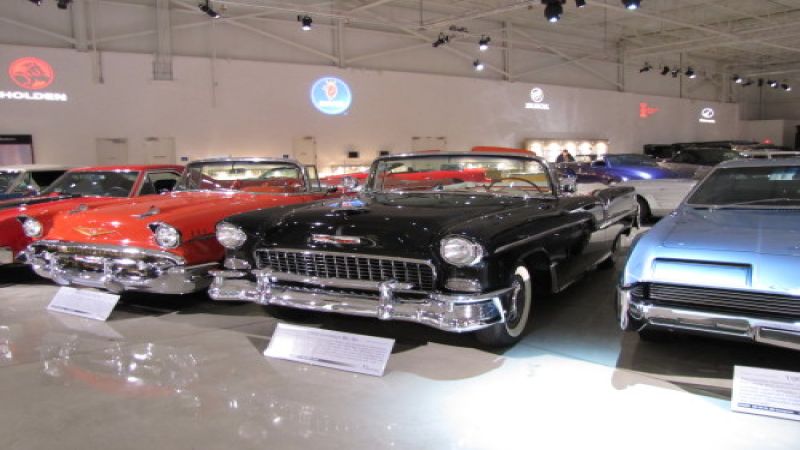Look at that photo. A visit to the GM Heritage Center in Sterling Heights, Michigan is a classic example of what can and had been accomplished long before there ever was a single CAD system in the arsenal of Detroit's auto industry. Now multiple systems permeate the industry, but something got lost in the process: designer skills portability which is still affecting the unemployment level.
The last time I called upon the SAE to help lead the auto industry toward slimming down the eclectic list of CAD systems in the auto industry, nothing really happened except an email. So, in light of companies complaining they cannot find qualified U.S. engineers and CAD designers, allow me to state the case once again.
CAD (Computer Aided Design) tools are used by engineers and designers to design, integrate and develop automotive products, at least in Detroit. Problem is, too many qualified CAD operators have been put at a disadvanatge, and so has the auto industry, which has been shooting itslef in the foot since 1980.
Ever searching for personnel with higher degrees as if that's all that is ever needed, they forgot what and who designs the parts: and it certainly is not a degreed manager. No, it's the CAD grunts sitting at their stations, who are pressured to attend more and more meetings with managers who cannot even create a 3D part. That, however, was not always the case.
When I first entered the drafting trade in 1969 at Holley Carburetor, I had a basic structural-mechanic education from the U.S. Navy, my own briefcase with a full set of drafting tools that my father gave me, and a desire to learn tool design. A few years later, I moved from tooling to industrial products; then eventually migrated toward automotive product development.
With each job move, from Holley, Benton, Johnstone Pump, Lectron Products, ISI Automation, Essex and finally to Saturn and GM, I took the same tools with me, but with increased experience and confidence as a tradesman. All my knowledge and skills were truly portable.
About 1980, CAD came along and changed the entire design field as a trade. The ability to design complex parts and vehicles in less time became a reality, but management’s fear of unionization contributed greatly to the decision for each automaker to select its own proprietary system; in essence, scuttling the ability of designers to move around like the old days.
Now, in order to increase the odds for a new job, designers and engineers have to be fluent and proficient in at least three of the many complex CAD systems. Here are just a few used by GM, Ford , Chrysler, Toyota, Hyundai, BAE Systems and their suppliers, and this list is far from complete:
- Unigraphics
- Catia
- Pro-E (Pro Engineer)
- AutoCad
- SolidWorks
- Alias (Studio and industrial design)
Now, imagine if the office environment had that many different operating systems; and Word, Excel and Powerpoint don't even come close to a CAD system's complexity.
Layoffs lead to crowded and difficult job searches
It’s not hard to imagine a designer today with at least a two-year technical degree or greater losing his or her job. They may even have a bachelor or their masters; perhaps spent the last ten or twenty years working diligently on one CAD system, perhaps a system like Unigraphics.
Now what should a designer do when the next opportunity has a different system? Go back to school or get a higher-tech job, when design IS already high tech?
I know there are many in the Detroit area who can relate. A designer might find a job on the web that uses UG, but has to fight the crowd for attention. So, he fires off his resume to another job. This one, however, demands Catia-V6, not V5 or V4; and they want years of experience, not a newbie. So, he looks at alternate industries like aerospace or military only to find their job requirement may be Pro-E. Get the picture?
Industry paybacks are always hell
The seeds of today’s CAD skill-portability problems were sown long ago. It’s not a designer’s fault. Now, most employers want everything, a jack of all trades and master of all. They want a designer and an engineer all in one; hence the term, design-engineer. But, they don’t want to lessen the workload like meetings.
The modern design-job paradigm demands, not just knowledge of many CAD systems, but proficiency in each; and no more sole reliance on IGES or STEP translators.
Missing is the realization that the engineering degree may be fully portable, but the CAD skills are not. Why? Any CAD is a complicated system; and even with a common system, there are too many disjointed methods of modeling.
Some use 3D chunky solids; others use 3D parametric modeling with sketcher features. Heck, some companies segregate integration criteria from part modules; then spend time and money revisiting packaging issues that should be automated. Talk about inefficiency and wasteful allocation of resources.
This, I believe, is the direct fault of most company’s greed for control, and its degreed ignorance to be sold a bill of CAD goods that now shoots them in both feet. It all started when they got rid of design managers who were realists, because those came from the board. Higher management types instead opted for the advice of CAD specialists who know and sell systems, but cannot design to save their neck; and fail to see the big picture of design as a trade, not just a profession.
My past design managers like Fred Hafer, Doug Drouillard, Gerry Milner, Frank Guglielmi and Pat Johnson understood the breeding it took just to design on the board, let alone use a CAD system. It certainly took more than a sheepskin with hunting and pecking skills. It required pure time in grade; in other words, time modeling away from redundant meetings – a distraction from proficiency and a full-time job in its own rite.
The dilemma has a viable solution
The industry lost something it once cherished – the sensibility to recognize the value of knowledge and skill portability. Today, automakers suffer mostly from lack of vision or inaction; and always resorting to more and more training as the only way to counteract any dilemma.
I say the high cost of education now demands the auto industry to refocus on one design system. In other words, let’s get back to that portability we once knew. We did it with SAE standards and data translators. Imagine a skilled pool of designers and engineers, common in standards and fully portable. That would be good for the industry, as well as Detroit’s high-tech economy.
In the meantime, I urge SAE once again to drive sensibility back into the industry. I can do my part at this post, but it takes a village as someone once said; in this case, an engineering village with some sensibility.
-----------------------
Full Disclosure: At time of publication, Sherosky, creator of the auto sector charts for TN, is neither long or short with the mentioned stocks or futures, though positions can change at any time. None of the information in this article constitutes a recommendation, but an assessment or opinion.
-----------------------
About the Reporter: After 39 years in the auto industry as a design engineer, Frank Sherosky now trades stocks, futures and writes articles, books and ebooks like, "Perfecting Corporate Character," "Awaken Your Speculator Mind", and "Millennial World Order" via authorfrank.com. He may be contacted here by email: [email protected] and followed in Twitter under @Authorfranks
________________________________________________
Additional Reading:
Carl Icahn stakes his claim on Navistar, stock rises after hours after market down day
Tech synergies permeating IC engine development per 2011 DEER Conference
S&P upgrades GM credit rating, places Ford on upgrade watch, and GM responds
Tour Split-Cycle Engine technology display
Altair unveils world's first hydraulic-hybrid transit bus
Scuderi Split-Cycle Engine achieves 65 MPG under simulation study
Achates Power addresses commercial truck mileage and emission standards
Raytheon: Cyclone Power's combustion engine game changer












Comments
Frank Sherosky, a name out of
Permalink
Frank Sherosky, a name out of the past.
You certainly changed gears in your career. How in the heck did you end up as a writer?
Not that I had any doubt that anyone who managed to master the design system that GM used could be successful at any endeavor that he chose.
Frank, I hope that you and your family are well.
It certainly was a surprise to see my name in your list of capable design managers that you worked with but it also makes me proud that you thought so.
As you may already know, after I left Saturn burned out from fighting the same battles that you oviously fought yourself, I took it easy for a couple of years to give my brain a chance to recover and then I went back to work as a design manager. During my "second career" I was involved in electrical, hvac,body exteriors and just about everything else connected to automobile design.
In 1998 I was involved in the design of a prototype hybrid vehicle exactly like the Toyota Prius, which has received high praise. Well, they ended up cutting it up and scrapping it because they felt that it would never sell in the volumes required to make it pay. Meanwhile the Japanese government subsidized Toyota until the Prius started to make a profit and consequently Toyota received accolades from every auto critic as to how inventive they were as opposed to the "stodgy" American companies. If only the total truth would come out about the unfair practices that the Japanese and Korean companies used to try to take over the domestic auto market.
Please reply and fill me in on the rest of the Saturn alumni if you can.
Sincerely
Frank Guglielmi
Bravo, Well said. I was a
Permalink
Bravo,
Well said. I was a Board Draftsman. Began in the late 70’s as a “Runner”. Minded my Peas and Q’s and eventually became a “Detailer”. Took “Batavia” and followed that with the “Philpot” course. As my confidence was raising and I was about to go into “Layout”, along came a computer system called, “CADDS 4X”. Eager to go with the flow, I took the classes and moved into “Layout”.
Jumped job shops for a few dollars, took my new knowledge with me and landed Design work with a GM program. As luck would have it, a few years later, another company called offering training on another system called CATIA V4. Worked mid-nights, worked hard. Four years went by and a company called looking to train Designers in Unigraphics/Sun System. Off I went, for more money and training.
Chrysler would call in the mid 90’s. Was I interested in CATIA V4? Absolutely, says I. I barely got back up to speed and along comes CATIA V5. Granted CATIA V5 lasted a few more years than the others, but by 2009, the Italians had decided that NX was going to be the way to go. For years we’ve been trying to make the switch, migrating data from CATIA to NX. With no shortage of problems I might add.
Gone are the days of working under the wings of senior employees. Doing your time, making the grade and moving up to the next position. No more apprentice programs, etc. Sit down, do the work, go home and start all over the next day. You can sit next to someone for years and never know what their experience was, or even how to share their knowledge. What a crying shame.
Hi Frank, You sure did nail
Permalink
Hi Frank,
You sure did nail that one my friend. I am a Senior Designer. My designing career started with Kelsey-Hayes in 1974 working on the board on Air Brakes and has ran the gamut from a small design shop in Swartz Creek doing work for Rochester and AC Spark Plug to contract inside GM and my current position at another company in Livonia.
I started in this profession right out of high school in 1974. I have NO college background at all. I have seen all of this happen, not only with the computer design area but in the lack of practical knowledge to APPLY to the design. I worked on the board, detailing and designing, until 1986 when the shop I worked for started their computer program with Applicon Systems. I left there in ’93, going into the GM Tech Center in Flint through a Contract house. Everything I knew in Applicon went right out the window! Training in Unigraphics V9 was difficult to say the least. There was no formal training. There should have been, it would have made the transition much smoother. After running UG for almost 18 years now (currently UG NX6) I can say I am very proficient but I also brought a basic design knowledge, ( i.e., Draft, stamping, forming, etc.) to the 3D world that I learned ON THE BOARD. Many of our “designers” today can run the system/s but so many of them lack an understanding of HOW to design a viable part… This all comes with experience I know but it is something that should be taught with a higher priority in the schools and colleges.
Thanks for taking your time to read this.
Mark A. Smakal
Senior Designer
Your article about the
Permalink
Your article about the "Detroit auto industry still suffering from lack of CAD designer skill portability" was passed on to me to read and I just want to say that you hit the nail right on the head. Nothing but the truth. It would only make sense to have one common CAD system.
In todays world of looking for a design job it's like if you don't know "everything" they don't even want to finish the conversation. I have been out of work since 2006. Try finding a job in todays world when you are 62 years old. It's not going to happen easily.
It's definitely not like it was pre-CAD.
I was gratiously thrown on the street (basically freakin' blindsided) by GM in 2006 (@57 years old and not ready to retire) when there was a salaried employee reduction. (don't get me wrong, I am not bad-mouthing my previous employer because they say that is not the correct thing to do. Yeah right!) They always preached to us about honesty, loyalty, and integrity. I soon figured out what they taught us did not apply to them. The teaching was only the employee to the company, NOT the company to the employee. Other than working 5 years for VWof America I always worked on GM programs. The last 12 1/2 years direct for them. Didn't matter.
Back then things were going belly-up and if you were not fortunate enough to be kept working things would only get worse. The people that were working got trained in house in a couple of newer CAD versions. Now the people on the street are not only out of work, they are not up-to-date with the new versions. Now when you call on a job, if you are not up to date on the latest version...oh well. Sorry. Never used excel, huh, sorry. Next!
When working for GM we were trained in GD&T but we never actually had to apply it because there was an actual GD&T group. If our job needed it we just sent it to them and they did it. Simple. Now, if you don't know how to apply GD&T, and it is a requirement, you might as well not even call on the job posting. They don't even want to talk about sending you for 2 days re-training.
You were correct in saying that most (not all because some do) managers have no concept of what it takes to design a part in CAD. They thing, ok I need a new bracket, or a new hood, or a new whatever, that there is a button to push for that part and bingo, there it is! No idea.
They see these dog and pony shows from CAD instructers who make it look so simple. They demo the same part they have been doing for years and these managers or executives get so dazzled by it that they have to have it. These are the people, pretty much like what you said, came with their sheepskin but had no idea of design work. When I was working old job shops and places like VWof America, the head people came from the board. They worked their way up. Some engineers actually were from the board and didn't even have a degree, but...they had experience. We never had 1/2 of the processes they have today and looking back, things went much smoother.
As you can tell it's pretty frustrating.
We won't even talk about age discrimination because as you know, companies do not discriminate because of age.
Again, try being 62 and find a job.
Hi Frank, I agree with the
Permalink
Hi Frank,
I agree with the article you wrote on CAD designer portability, 100%. I am in the situation in Europe of being trained on the board and layout table in the late 70’s in Pressed Steel fisher. I was one of the last full intake of apprentices, there were 12 in my year, 8 in the year after, 4 or 5 the year after that and then it was all graduates from university. Who, through no fault of there own didn’t want to draw auto bits but wanted to become managers and that is what most of them did. So the apprentices where already being passed up when it came to promotion by the graduates.
I was one of the first in the Auto world to be trained on Cadam (2D) and CATIA (3D), except it wasn’t’ called version 4 then because that was all there was.
I worked for Volvo in Sweden and realized that I had to break into another CAD package if I was going to get on, so in the early 80’s at 25 years old I went down to Ford in Australia to learn PDGS. We were told by the agent that they wanted people with CATIA so they could re-train them but when we got down there they had been slightly economical with the truth and Ford had no intention of teaching us PDGS. I was put on manual, which suited me fine.
I went back to the UK and got trained on PDGS to help do the Lincoln town car in mid 80’s. With PDGS under my belt I had broken into Ford and from UK I went to Germany, USA and Japan.
After a second job in Germany on PDGS I found a job with Nissan in which they trained me on their own system CAD2 and was sent to Spain. While I was in Spain the world moved on, there was always Unigraphics and a smattering of Alias around but in the 90’s there was an explosion, or so it seemed of CAD packages .
CATIA V4, PDGS & CAD2 where just tools to use, you could apply principles of manual drafting to them but then came solid modeling. Bought by Managers, who didn’t have to work the systems or know how to work them but were bamboozled by very cool rotating graphics. I remember having a discussion with an IDEAS trainer who told me it would take 2 years to get proficient at the system and I said that was a retrograde step taking 2 years to learn how to use what was basically a tool because by the time people got proficient then the job they were working on would be over and the OEM would be onto a different system! It seems that know every OEM has it’s own propriety system.
I feel that the original systems although great for body, trim and tool draughting weren’t so good for engine design or packaging and were originally, in their green line form, quite graphically light where as solid modeling is very graphics heavy and look a lot better to show people who don’t know, necessarily, what they are looking at.
I now work for Nissan in the UK where the title engineer is just a pay grade and I have to attend at least 3 meetings a day, it seems that the bean counters have won the day all decisions come from Japan, the majority our CAD engineers a bussed in every day and come from Nissan India and are obviously cheaper than employing a local.
As a 26 year old these kinds
Permalink
As a 26 year old these kinds of comments are precisely those that are of incredible value to me. I don't know whether to be fatalistic about this trend of events or merely realistic. But what I do know is that I will never ever again believe people (mostly the companies marketing themselves) who paint a picture which is all too picture-perfect. Because while it seems logical that a company would be run efficiently and everything is sunshine and rainbows however reality is too complex to have that be the reality all of the time, the only question is how often is it a reality: most of the time, some of the time or almost never. That's the question I don't yet know the answer to.
You have not asked me how to
Permalink
You have not asked me how to build a vehicle. That's your mistake. I am the consumer. Will somebody get to the American auto industry and tell them to make these changes . . . just three items. I have several, but complexity spawns disinterest. Change that single 180° bottom spoke in the steering wheel to a four-spoke steering wheel affording at least a four-finger-wide comfortable opening at the bottom; design the steering wheel to tilt near the back of the steering wheel (not way under the dash with that lever requiring two hands to operate); and give me AND my wife a fully functional power seat without having to purchase some juvenile-related luxury package. Give us what we want. We will buy.